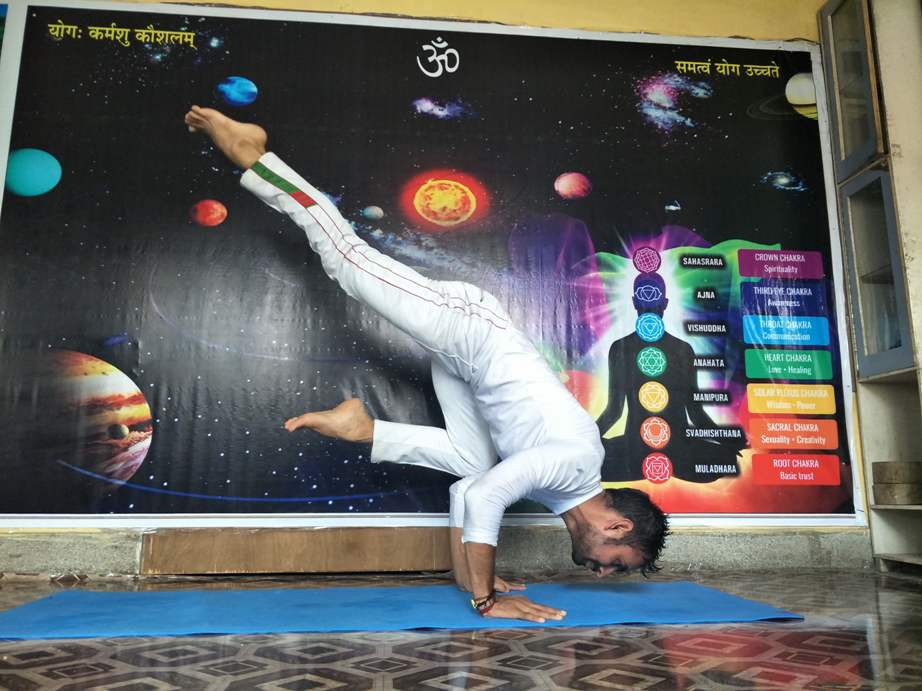
Astanga Yoga
Ashtanga yoga is named after the term given in Patanjali’s Yoga Sutras for the eight-fold path of yoga, or ashtanga, meaning “eight-limbed” in Sanskrit. It was Sri K. Pattabhi’s belief that the asana "limb" of yoga must be practiced before the others could be mastered. The practice was developed in Mysore, India where Sri K. Pattabhi Jois taught and set up the Ashtanga Yoga Research Institute.
Ashtanga vinyasa:- Opening Mantra
वन्दे गुरूणां चरणारविन्दे सन्दर्शितस्वात्मसुखावबोधे । निःश्रेयसे जाङ्गलिकायमाने संसारहालाहलमोहशान्त्यै ॥ आबाहुपुरुषाकारं शङ्खचक्रासिधारिणम् । सहस्रशिरसं श्वेतं प्रणमामि पतञ्जलिम् ॥

vande gurūnāṃ caraṇāravinde sandarśita-svātma-sukhāvabodhe | niḥśreyase jāṅgalikāyamāne saṃsāra-hālāhala-moha-śāntyai || ābāhu-puruṣākāraṃ śaṅkha-cakrāsi-dhāriṇam | sahasra-śirasaṃ śvetaṃ praṇamāmi patañjalim ||
There are several key principles that underlie the practice of Ashtanga yoga:
- Breath: It is recommended that postures are held for five to eight breaths or more, if possible.
- Drishti: For every posture in the series, there is a set of drishtis, or gaze points.
- Vinyasa: This is the breathing system that connects every movement in the series with the breath.
- Bandhas: The practice should be carried out with the bandhas, or "body locks," engaged in order to ensure that the breath is also correct.
- Daily practice: A six-days-per-week practice is encouraged, with Saturday as the rest day. The days of the full and new moon should also be taken as rest days, and women may also refrain from practicing during menstruation.
- Surya Namaskara A (5 times)
- Surya Namaskara B (3 times)
Ashtanga yoga classes are often taught in the “Mysore style.” In this style, practitioners are encouraged to memorize the sequence they are working on, then individually work through the sequence during the class. The teacher then comes around to adjust and support, rather than guiding the individual's practice. Thus, the students set their own pace consistent with their ability, but practice in the company of other students and with the encouragement of their teacher. They should master each pose in the sequence before they move on to the next. Ashtanga yoga is considered a vigorous, orderly practice and, as such, is more suited to students who want a dynamic and rigorous yoga practice.
(स्वस्ति प्रजाभ्यः परिपालयन्तां न्यायेन मार्गेण महीं महीशाः । गोब्राह्मणेभ्यः शुभमस्तु नित्यं लोकाः समस्ताः सुखिनो भवन्तु ॥ ॐ शान्तिः शान्तिः शान्तिः ।

svasti prajābhyaḥ paripālayantāṃ nyāyena mārgeṇa mahīṃ mahīśāḥ | go-brāhmanebhyaḥ śubham astu nityaṃ lokāḥ samastāḥ sukhino bhavantu || Oṃ śāntiḥ śāntiḥ śāntiḥ |
May the rulers of the earth protect the well-being of the people, With justice, by means of the right path. May there always be good fortune for cows, Brahmins and all living beings, May the inhabitants of all the worlds be full of happiness. Oṃ Peace, Peace, Peace!

